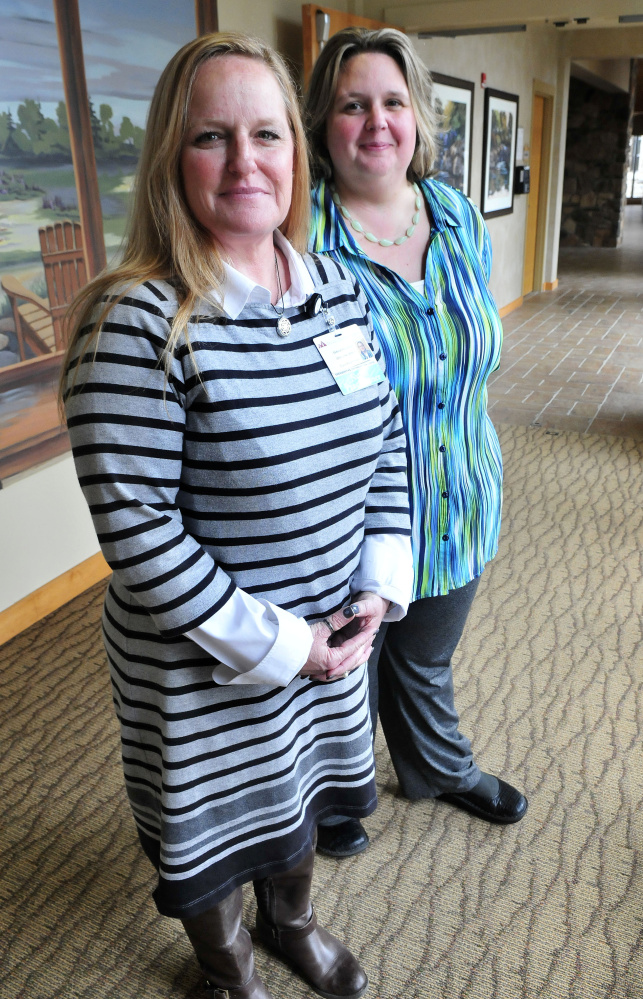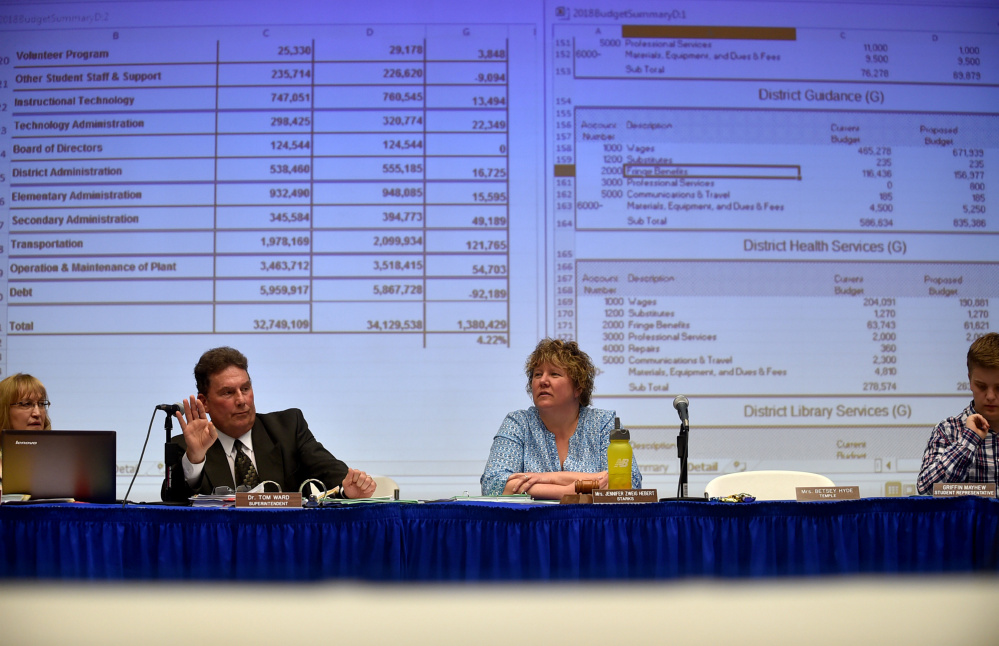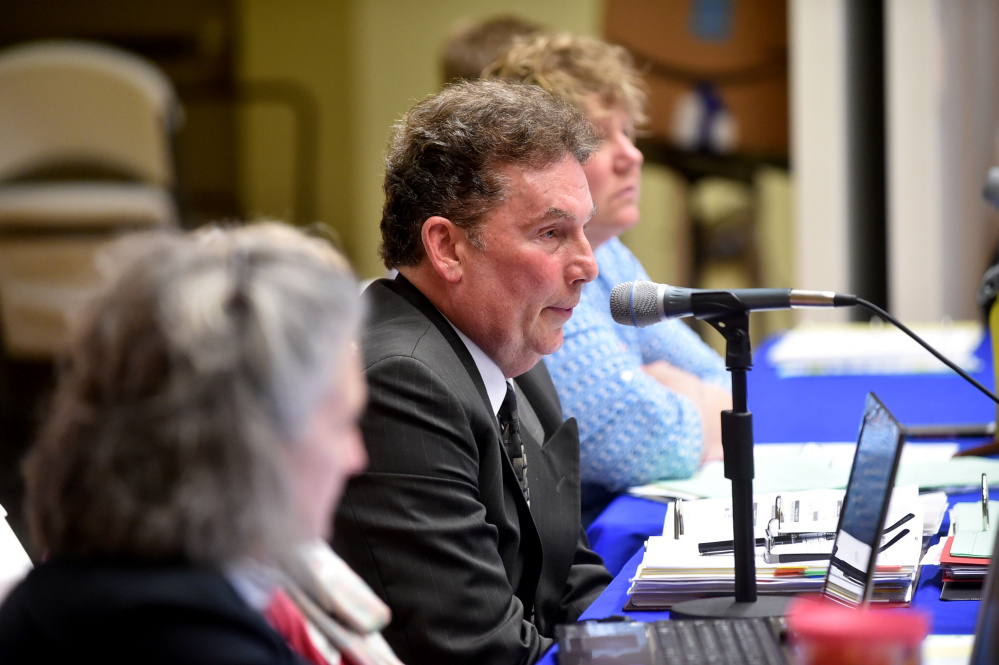FARMINGTON — Deborah Burchfield and her partner had a specific adviser in mind as they weighed whether to pack up their Pottsboro, Texas, home and move more than 1,900 miles to Farmington.
Burchfield, a nurse practitioner with over 25 years of experience, came to Maine in September to interview for a position in the Franklin Community Health Network. She had visited the state for years, receiving her master’s degree in nursing from Saint Joseph’s College in Standish and even marrying her partner at French’s Point in Stockton Springs.
When it came to settling in Maine for good, however, Burchfield needed to hear from one person: her 9-year-old son, Rhett.
“I wanted to make sure, number one, that he was on board with us moving, because otherwise that wasn’t going to happen,” Burchfield said.
Rhett was home-schooled in Texas, and Burchfield wasn’t sure how the transition to a Maine public school would go. He was accustomed to learning at his own pace with the freedom to work while standing, seated at a table or spread out across the floor, as he had previously at a Montessori school. But after touring Academy Hill School in Wilton and speaking with teachers, administrators and even Superintendent Thomas Ward, the family — and Rhett in particular — jumped to join the Regional School Unit 9 school district.
Jodi Cordes, the Franklin Community Health Network physician recruiter who helped guide Burchfield through her interview process, said Burchfield’s focus on educational opportunities is typical of medical professionals considering a move to the area. As the RSU 9 board works to finalize its 2017-2018 budget proposal, Cordes said contention over the budget in recent years has made recruiting efforts more difficult.
“It was really hard, I will say, last year, wondering how to try to show the community in a good light when the signs were all around the community about vote ‘yes,’ vote ‘no’ for the school (budget),” Cordes said. “You’re trying to say how awesome the community is, and they’re saying there are so many people against the schools. What’s wrong with the schools?”
OLD FIGHTS LOOM LARGE
The RSU 9 board of directors is scheduled to deliver its recommendations Tuesday for the district’s 2017-2018 budget. Voters will have a chance to weigh in on that budget May 31, then again at the annual budget referendum, on June 13. But as the district pushes to address previous years’ budget shortfalls, tensions have flared between RSU 9 town residents who view the budget as an overly bloated burden on local taxpayers and those who see increasing school funding as key to creating new forms of economic opportunity in Franklin County.
At the heart of the conflict is a long-debated question about whether and to what extent funding affects student performance. Those pushing for higher budgets argue that schools, especially those in lower-income areas, often need to stabilize students in order to make them able to learn effectively. For some students, that might mean providing clothing and meals, or mental health or behavioral counseling. For others it means intensive one-on-one tutoring to get them up to the same educational level as their classmates.
Since he started work in 2013 as RSU 9’s superintendent, Thomas Ward also has pushed for higher salaries for staff members, saying the district has been losing more experienced teachers and administrators to neighboring school districts where they can make an additional $8,000 a year. Schools feel that loss in the classroom, Ward said, especially when it comes to the classroom environment.
“When you’ve got somebody who at least has five years’ experience, you’ve got a different teacher, because your discipline issues go down,” Ward said. “Our goal is for everyone to have the same classroom climate that’s conducive to learning, so you have to have a disciplined classroom climate; and if you don’t, there are kids in there suffering because they can’t improve academically.”
Critics of RSU 9’s rising school budgets say the tax burden on local property owners is becoming unsustainable, especially in communities with elderly or declining populations. Bob Neal, a selectman in New Sharon who helped build seven budgets during his years on the SAD 9 board, said his own property tax bill has doubled since the town’s 2007 revaluation.
“The local share is just continuing to go up at a much faster rate than incomes or economic growth can justify,” Neal said.
In the 2014-2015 school year, RSU 9 paid a total of $13,191 per student, with $4,286 going toward regular instruction, $1,391 for special education and $605 for vocational education instruction. Statewide average spending per pupil for that year was $12,551, including $5,127 for regular instruction, $1,953 for special education and $255 for vocational education. Much of the discrepancy in overall spending comes down to RSU 9’s debt service spending. In 2014-2015, RSU 9 spent $2,676 per student toward debt service, versus the statewide average of $756. Ward said the district is paying off elementary school and Mt. Blue campus building projects, though he added that the state is paying the vast majority of those costs.
Neal also points to research demonstrating that increases in school funding do not necessarily result in better student performance. One 2014 study by the libertarian Cato Institute charted SAT scores dating back to 1972 against rising school funding rates over the same period and found the two did not appear to be related.
“The performance of 17-year-olds has essentially been stagnant across all subjects despite a near tripling of the inflation-adjusted cost of putting a child through the K-12 system,” the study’s authors wrote.
But other researchers say it’s when funding is targeted toward the highest-need students that schools see the greatest improvement. In a 2016 study, researchers from the University of California, Berkeley and Northwestern University found that post-1990 school funding reforms that increased funding to low-income school districts resulted in “gradual increases in the relative achievement in low-income school districts.”
In presentations to RSU 9 town select boards this year, Ward described how district schools have been grappling in recent years with what they believe are the increasingly dramatic effects of poverty on students. From the elementary schools up to Mt. Blue High School, teachers and administrators are reporting spikes in student mental health problems as well as in an influx of children with special education needs who often require out-of-district treatment that schools are required to pay for. Over the last two years, Ward said, students with $300,000 worth of special education needs moved into the district after its budget had been set, in a kind of unexpected financial shock that has forced Ward to freeze the district’s budget for the last three years running.
“It’s a tremendous issue,” Ward said. “It’s hard to really tell where this all starts, but we really think (these are) poverty issues.”
According to Kids Count, a project that collects data tracking the well-being of children in the U.S. over time, 21.4 percent of children under the age of 18 in Franklin County were living in poverty in 2015 compared with 17.5 percent statewide. Franklin County ranked seventh that year after Piscataquis (30.5), Washington (28.8), Somerset (25.9), Oxford (25.6), Androscroggin and Aroostook counties (both 21.8). Franklin County’s numbers have remained relatively stable over the last decade, ranging from a high of 24.9 percent of children living in poverty in 2012 to a low of 19.5 percent in 2006.
POVERTY IN CLASSROOMS
Ward argues that poorer families are having to work harder to support themselves than they used to, as wages have failed to keep up with the cost of living. Over the more than 40 years he has spent in and out of the RSU 9 district, Ward says he has seen parents working more, often in multiple jobs, and still finding themselves struggling to house, clothe and feed their children, let alone spend time with them.
“We’re consequently having to deal with those issues in our schools. More and more kids we have clothes for, we’re doing breakfast programs, we’re doing after-school programs,” Ward said. “We’re sending them home with food. I think that’s the real crux of the change, is just more families in crisis, and that directly impacts students’ mental health.”
Distressed by the trends, Ward decided to start a safe-schools committee to bring together educators, first responders and area agencies to discuss what they were seeing in schools. Out of that committee came a consensus that the group should focus its efforts on creating a system of support for people, and especially children, living in poverty in Franklin County.
With the aid of The Healthy Community Coalition of Greater Franklin County, the group secured a three-year $145,000 grant from the Maine Health Access Foundation to bring in Donna Beegle, a nationally known poverty expert, to train Franklin County educators, agencies and volunteers in the Opportunity Community Model, which takes a communitywide approach to dealing with poverty. Through the program, volunteers are trained as navigators who help connect people in poverty with local resources, including educational and skills training. The group kicked off its initiative last month.
Alison Hagerstrom, executive director of the Greater Franklin Development Corp., said school systems also can play a key role in attracting new economic development to a region. Hagerstrom points to RSU 9 offerings such as the composite manufacturing program at the Foster Career and Technical Education Center on the Mt. Blue High School campus as an example of the type of local educational resource that businesses find attractive.
“It speaks to the talent pool and it speaks to the type of students that come out of our school system here,” Hagerstrom said. “It’s just huge.”
Hagerstrom said she routinely takes business owners she’s trying to recruit to the area on tours of Foster Tech’s facilities, often bringing them to lunches crafted and served by the school’s culinary arts students.
‘AN ECONOMIC ENGINE’
Before joining the RSU 9 board of directors last year, Doug Dunlap, of Farmingon, taught at the University of Maine at Farmington and helped found the Franklin County Community College Network — now called FCNet — to help bring community college courses to the county, arguing that people and businesses are more likely to move to and remain in the area if they know that a wide array of educational opportunities are available. Dunlap described such school systems as “an economic engine in a community.”
“That’s not their only role and it shouldn’t be seen only in that way, but they are to the extent that individuals and families may decide whether to stay in a community or move to a community because of the quality of schools,” Dunlap said. “There are also people who have a business or a service that certainly depends upon qualified personnel to work in those businesses, so they look to a school system to be able to provide knowledgeable and well-skilled people.”
As a new board member, navigating his first school budget approvals process, Dunlap said he is focused first on how the district is serving the needs of its students and whether it is going about its efforts in the most cost-effective way. At the same time, he said, he is thinking about how the board’s decisions might affect long-term economic development in the area.
One of the major challenges the RSU 9 board faces each year is that it must decide on the district’s budget before knowing how much money the district will receive from the state. That problem is only magnified this year, as the LePage administration has proposed ending state funding for district administration costs in an attempt to cut down on what the governor has deemed redundant central offices.
“We have too many superintendents, and what we’re looking at is to regionalize — not consolidate, but regionalize,” LePage said at a news conference earlier this month. “If local school districts want to go at it alone, we are not going to interfere. If local taxpayers want to have a local superintendent, let them pay for it. Let us pay for the students.”
LePage’s proposal would mean a prospective loss of $500,000 for RSU 9, Ward said; and with no guarantee of how the Legislature will vote, the board must move ahead as though the funding gap will be filled by RSU 9 towns. Highly aware of the burden such a change might pose for taxpayers, the board has been working its way through the budget line by line, eliminating non-essential programs along the way.
RSU 9 PERFORMANCE TRAILS STATE
But Cordes warned that even these types of cuts can harm local recruitment efforts. In recent years, she said, the district has cut back or done away with language programs that appealed to parents considering a move to the area.
“The one thing I still hang on is the violin at RSU 9. They think that’s awesome,” Cordes said. “I just hope that doesn’t go away.”
The one area Cordes said she cannot change or prevent prospective hires from exploring on their own is school performance data. In the 2015-2016 school year, only 28.12 percent of RSU 9 students met or exceeded state standards on the Maine Educational Assessment mathematics tests, compared with 38.31 percent of students statewide, according to Maine Department of Education data. Fewer than half of RSU 9 students, 40 percent, met or exceeded English language arts and literacy standards, compared with 50.59 percent statewide. On state science examinations, 53.67 percent of RSU 9 students met or exceeded state standards, compared with 60.97 percent of their peers across the state.
“We have beautiful buildings, but what’s going on inside them?” Cordes said.
Kate McCormick — 861-9218
kmccormick@centralmaine.com
Twitter: @KateRMcCormick
Send questions/comments to the editors.








Success. Please wait for the page to reload. If the page does not reload within 5 seconds, please refresh the page.
Enter your email and password to access comments.
Hi, to comment on stories you must . This profile is in addition to your subscription and website login.
Already have a commenting profile? .
Invalid username/password.
Please check your email to confirm and complete your registration.
Only subscribers are eligible to post comments. Please subscribe or login first for digital access. Here’s why.
Use the form below to reset your password. When you've submitted your account email, we will send an email with a reset code.